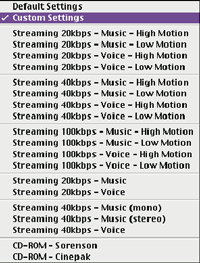Review: QuickTime 4

Product Information
Published by: Apple Computer, Inc.
Web: http://www.apple.com/quicktime
Requires: 68020 CPU or later running Mac OS version 7.1.1 or higher, with Open Transport version 1.2 or higher. Streaming functionality requires a PowerPC-based Macintosh. In addition, the computer must have at least 8 MB of RAM for 68K machines, and 16 MB of RAM for PowerPC systems, and either a static IP address or a DHCP server.
Price: free playback; pro edition, which includes authoring costs $29
A few years back when Apple was still struggling to just regain balance, it started a process of technology blind fire, shooting aimlessly in all directions to hit any target anywhere. Amazingly enough, out of the many victims (Newton comes to mind) shone an unsurpassed technology winner that just about revolutionised the computer industry. QuickTime is Apple’s award-winning, industry-standard, software architecture for creating and playing digital media for Mac OS and Windows.
 In its latest release, QuickTime 4.0 makes working with video, animation, sound, music, text, pictures, interactive images, and 3D graphics easier than ever. There is even support for live video, audio streaming, Macromedia’s Flash file format, and MP3 audio files.
In its latest release, QuickTime 4.0 makes working with video, animation, sound, music, text, pictures, interactive images, and 3D graphics easier than ever. There is even support for live video, audio streaming, Macromedia’s Flash file format, and MP3 audio files.
But What Is QuickTime Exactly?
Strictly speaking, QuickTime is just another multimedia format which runs on computers that have the QuickTime software installed. So what’s the big deal? Well for starters, QuickTime is operating system independent, so it can run on a multitude of platforms. Think of it as an algorithm library, which can translate, compress, filter, and play digital media. It can be used by amateurs and professionals alike in various fields of work, including multimedia artists, musicians, corporate executives etc.
How does QuickTime Work?
At its core, QuickTime operates in a very simple way to capture video and sound, and then use software compressors to optimize them for playback on personal computers. QuickTime supports so many formats that it should meet just about anybody’s multimedia needs. To give you a clearer idea of its abilities, I have listed below the formats supported by QuickTime 4.0 in Figure 1.
But How Well Does It Perform?
Too well, actually. Putting aside the awkward “KPT-like” interface (which I personally find to be sexy) the software really does excel at what it does. The speed, ease of use and support are just unsurpassed.
Recapping, just like Adobe Photoshop has become the de facto standard of image manipulation, QuickTime has become the de facto standard of low- to middle- end digital media. Recommended for everyone! I almost forgot my wish list item: could we please have an MPEG Export option? Pretty please?
Reader Comments (5)
Peggy Oestreich peggyo@grandecom.net
But this only works on a 400 MHz G3 or newer (or you must be running Windows 2000 or XP if you're installing on a PC).
If you need a version that runs on older computers, you can download version 6 that works on Mac OS 9, or version 5 for older PCs: http://www.apple.com/support/quicktime/
Add A Comment